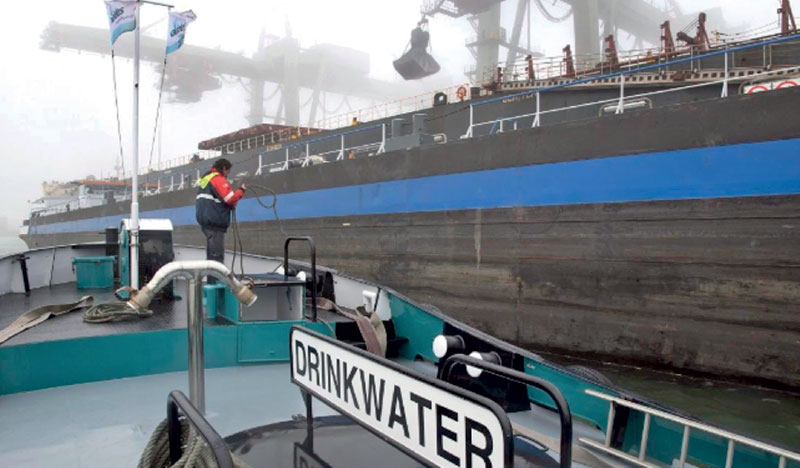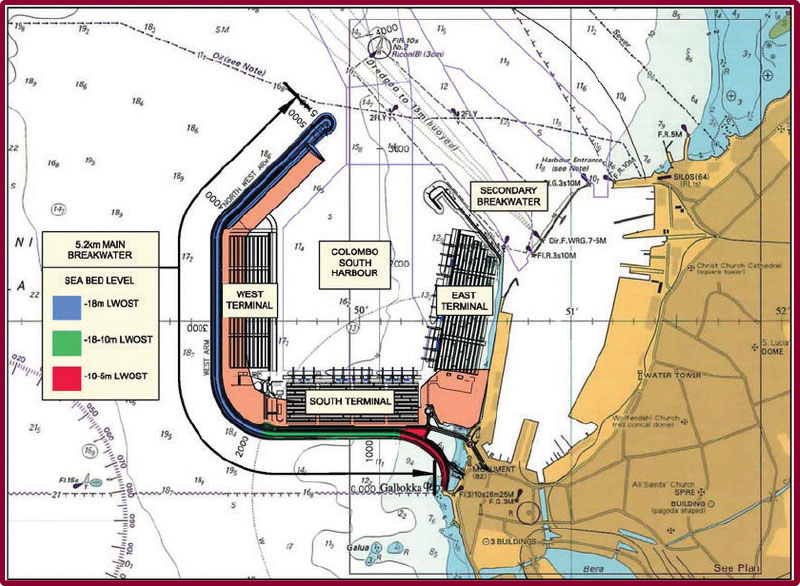Monday Jun 16, 2025
Monday Jun 16, 2025
Monday, 16 June 2025 03:06 - - {{hitsCtrl.values.hits}}


Currently, bunker prices at Colombo Port are much higher (+$50/MT) than at Singapore and UAE. The difference can be brought down with the introduction of deep water bunkering terminal. Colombo is expensive overall due to the fuel premium. However, if Colombo’s fuel premium can be narrowed (e.g. $10/MT higher than Singapore instead of $ 30), the combined cost of bunker + fresh water would nearly breakeven with Singapore.
The takeaway is that cheap water substantially reduces the total refuelling bill in Colombo, though it cannot fully counter very large fuel price gaps. In many realistic cases the bunker price differentials in the region are within a few percentage points; thus, Colombo can use water pricing to neutralise a moderate disadvantage or even achieve a slight overall cost edge. Shipping lines often calculate such total costs when planning where to bunker. By ensuring Colombo’s package (fuel + water) cost is at or near parity with Singapore (and better than ports like Fujairah or Mumbai in some cases), the port becomes a viable and attractive alternative.
It’s also important to note that fresh water quality and quantity in Colombo would be assured as part of this offer – the water is supplied from the national grid (treated potable water) rather than from uncertain sources. This means ships get not only cheaper water, but high-quality drinking water for their tanks. In Singapore, although water is high-quality, the escalating cost for large volumes might discourage vessels from fully filling their water tanks there. Colombo can encourage ships to take all their needed water without worry about cost. This could slightly increase the volume of water that vessels choose to bunker in Colombo (since it’s inexpensive, a ship might top off tanks more than they otherwise would). That in turn adds to the value gained by the ship during the Colombo stop, further justifying the call.
In summary, bundling fuel and water makes economic sense for ships when looking at total cost. Colombo’s new strategy would transform water from a costly line item into a negligible expense, effectively sweetening the deal for purchasing fuel in Colombo despite a small premium. The overall cost comparison underlines that Colombo does not need to beat Singapore’s fuel price to win business – it just needs to be close enough that the water bonus tilts the balance.
 Current vs. proposed fresh water pricing in Colombo vs. major ports
Current vs. proposed fresh water pricing in Colombo vs. major ports
Colombo’s water tariffs: The National Water Supply and Drainage Board (NWSDB) sets a standard tariff of Rs. 750 per cubic meter for supplying water to ships (Category 72: “Shipping”) (2398-19_E-water.pdf). Under current practice, the Sri Lanka Ports Authority (SLPA) charges about $ 8 per 1,000 litres (1 m³) for fresh water delivered by barge, with a minimum charge of $ 75 per delivery. This roughly equates to Rs. ~2,400–2,500 per m³ at recent exchange rates – 3 to 4 times higher than the NWSDB base tariff. The proposal is to instead offer water to vessels at the NWSDB’s tariff (Rs. 750/m³) plus only a minimal logistics margin. In practice, this could bring the effective price down to roughly Rs. 800–850 per m³ (≈$ 2.3–2.5), a dramatic reduction from current port pricing and very close to the local cost of supply.
Singapore’s water pricing: In Singapore – one of the world’s top bunkering ports – fresh water is considerably more expensive, and is billed on a steeply tiered scale. Water supplied to ships from the PUB (Public Utilities Board) mains is charged S$ 7.35 per 1,000 litres (~$ 7.35) for the first 50 m³, then rising to S$ 8.35 for the next 50 m³, and progressively up to S$ 21.35 ($ 21.35) per m³ for usage above 400 m³. There is also a 20 m³ minimum order (i.e. a minimum charge of ~$ 147 per supply) and an added water conservation tax on all sales. These rates reflect Singapore’s scarce freshwater – the port’s pricing incorporates costly desalinated/recycled water and import fees, plus taxes to curb heavy usage.
Other major ports: Other key bunkering hubs similarly have higher water costs. For example, Middle Eastern ports like Fujairah or Dubai rely on desalination for potable water, so their ship water prices tend to be on par with or above Colombo’s current $ 8/m³ rate (often in the $ 8–15 per ton range, with minimum delivery fees). European ports (e.g. Rotterdam) may have lower raw water costs than Singapore due to abundant supply, but still charge for delivery and infrastructure, typically a few dollars per ton. In India, ports have decent freshwater availability but historically haven’t leveraged ultra-cheap water as a competitive tool. In summary, Colombo’s proposed Rs. 750+ minimal margin pricing – equivalent to roughly $ 2.5–3 per m³ – would make it an outlier low-cost provider of fresh water among major ports.
Figure 1: Comparison of fresh water tariffs for vessels at Colombo vs. Singapore and Fujairah along with bunker prices and port charges. Colombo’s current port price (~$ 8/m³) is already similar to Singapore’s base rate (~$ 7.3 for first 50 m³) (Supply of Water | Maritime & Port Authority of Singapore (MPA)). The proposed Colombo rate (~$ 2.5) is dramatically lower. Singapore’s tariffs escalate with volume (up to $ 21+ for high consumption) due to its scarce water resources and added conservation taxes (Supply of Water | Maritime & Port Authority of Singapore (MPA)).

Bundling fresh water with bunker fuel – competitive advantage
Offering competitively priced (or even nominal-cost) fresh water bundled with bunker fuel can make Colombo more attractive to ship operators, even if Colombo’s fuel prices carry a slight premium. Typically, ship owners are highly sensitive to bunker fuel prices – historically, Colombo’s bunker fuel has been pricier than regional alternatives because Sri Lanka imports most of its fuel from hubs like Singapore/Fujairah (Sri Lanka sees positive bunker prospects on pricing economics ...). This has sometimes made ships bypass Colombo for cheaper fuel in India or Singapore. By bundling, Colombo can shift the decision criterion from just “fuel price” to “total cost of refuelling stop.” Key points include:
In short, bundling turns fresh water into a strategic loss-leader or value-add: Colombo sacrifices the high margin it could charge on water in order to make the overall bunker stop cost competitive. This can attract ships that would otherwise refuel elsewhere. The net gain for Colombo is in higher volume of bunker sales (and port fees), which likely outweighs the “loss” of not marking up water.
Moreover, providing both fuel and water together means ships can avoid an extra stop purely for water. In some cases, vessels might top up fuel at one port and then get water at another (especially if water quality or cost is an issue). If Colombo offers both at once, a ship can save time and scheduling complexity. This enhanced convenience and cost-efficiency strengthens Colombo’s value proposition despite any fuel price premium.
Strategic fuel transition plan (Years 1–10)


Marketing and pricing strategies for Colombo’s “fuel+water” value proposition
To position Colombo as the most cost-effective and service-complete refuelling stop in the region, a coordinated marketing and pricing strategy should be executed. Below are strategic recommendations:

Key takeaways
• Deepwater bunkering infrastructure alone strengthens Colombo but bundling fresh water strategically multiplies the advantage.
• Bunker volumes projected to grow from 500K MT to 5M MT over 10 years.
• Revenue potential exceeds $ 3.5 billion with a 2.5% net margin.
• Colombo’s low-cost water access creates a bundled advantage over regional hubs.
• The total cost of bunkering + fresh water in Colombo becomes highly competitive with Singapore and Fujairah.
• Faster berth access drastically improves vessel scheduling and operating economics.
• The bundled strategy delivers higher revenue growth, faster payback, and stronger long-term positioning.
• This transformation will position Colombo as the “Indian Ocean’s most efficient refuelling hub” by 2035.
• Faster berth availability drives higher customer preference.
• Compliments the government’s plan to expand and modernise the oil refinery at Sapugaskanda (SOREM project).
• A liberalised water policy in Sri Lanka Ports Authority shall create long-term port loyalty.
Conclusion
Developing deep water bunkering infrastructure at the Port of Colombo is not only feasible but also economically compelling. Although the required upgrades are capital-intensive, they are grounded in proven models from successful international port projects. An investment of around $ 125+ million could be recouped through steady growth in bunker sales, especially given Colombo’s strategic location on global shipping lanes. Over a 10-year horizon, the project has the potential to transform Colombo from being purely a container hub into a dual hub for both container handling and bunkering services, unlocking millions of dollars in new revenue streams and significantly strengthening Sri Lanka’s competitive maritime position.
Crucially, the comparison of scenarios shows that not pursuing this project carries a high opportunity cost. With regional competitors like Singapore, Fujairah, and even Hambantota actively capturing bunker markets, Colombo cannot afford to lag if it aspires to be a leading maritime centre in the Indian Ocean. By investing in a state-of-the-art bunkering facility — potentially via public-private partnerships to ease the financial burden on the state — Sri Lanka stands to secure long-term economic dividends and enhance national energy security. The Port City development offers an ideal platform to integrate this new oil terminal, complementing and expanding Colombo’s role as a critical logistics and trade hub.
Especially with the new condition introduced by the IMF to its ongoing loan program with Sri Lanka, calling for the abolition of tax concessions currently offered to the investors in the China-backed Port City project, the Government of Sri Lanka (GoSL) shall need to re-strategies its investment promotion programs and also to review how to use the Port City lands productively. Otherwise, the available option is to look at a Single Point Mooring Buoy (SPMB) installed off shore in the northern end of the Port of Colombo.
Moreover, by adopting smart pricing strategies — particularly using fresh water as a tactical loss-leader and maintaining tight bunker margins — and aggressively marketing its distinct advantages, Colombo can elevate itself as the go-to cost-effective refuelling hub in the region. This will require not only visionary initial steps but also an ongoing commitment to customer engagement, operational excellence, and service innovation. With phased execution, strategic partnerships, and continuous refinement, Colombo can realistically emerge as a dominant regional bunkering and maritime services hub, turning what was once a secondary port-of-call into a primary destination of choice for global shipping lines. In doing so, Colombo will not only diversify its port economy but also reinforce Sri Lanka’s broader position in global maritime trade.
(The writer is a former Chairman of Ceylon Shipping Corporation, Director of Ceylon Petroleum Corporation and Vice Chairman of Civil Aviation Authority. He is currently holding Board positions in several local and overseas companies.)

Part 1 can be seen at https://www.ft.lk/columns/Deep-water-bunkering-terminal-at-Port-of-Colombo-Feasibility-and-economic-impact-Part-1/4-777457
Discover Kapruka, the leading online shopping platform in Sri Lanka, where you can conveniently send Gifts and Flowers to your loved ones for any event including Valentine ’s Day. Explore a wide range of popular Shopping Categories on Kapruka, including Toys, Groceries, Electronics, Birthday Cakes, Fruits, Chocolates, Flower Bouquets, Clothing, Watches, Lingerie, Gift Sets and Jewellery. Also if you’re interested in selling with Kapruka, Partner Central by Kapruka is the best solution to start with. Moreover, through Kapruka Global Shop, you can also enjoy the convenience of purchasing products from renowned platforms like Amazon and eBay and have them delivered to Sri Lanka.
Discover Kapruka, the leading online shopping platform in Sri Lanka, where you can conveniently send Gifts and Flowers to your loved ones for any event including Valentine ’s Day. Explore a wide range of popular Shopping Categories on Kapruka, including Toys, Groceries, Electronics, Birthday Cakes, Fruits, Chocolates, Flower Bouquets, Clothing, Watches, Lingerie, Gift Sets and Jewellery. Also if you’re interested in selling with Kapruka, Partner Central by Kapruka is the best solution to start with. Moreover, through Kapruka Global Shop, you can also enjoy the convenience of purchasing products from renowned platforms like Amazon and eBay and have them delivered to Sri Lanka.